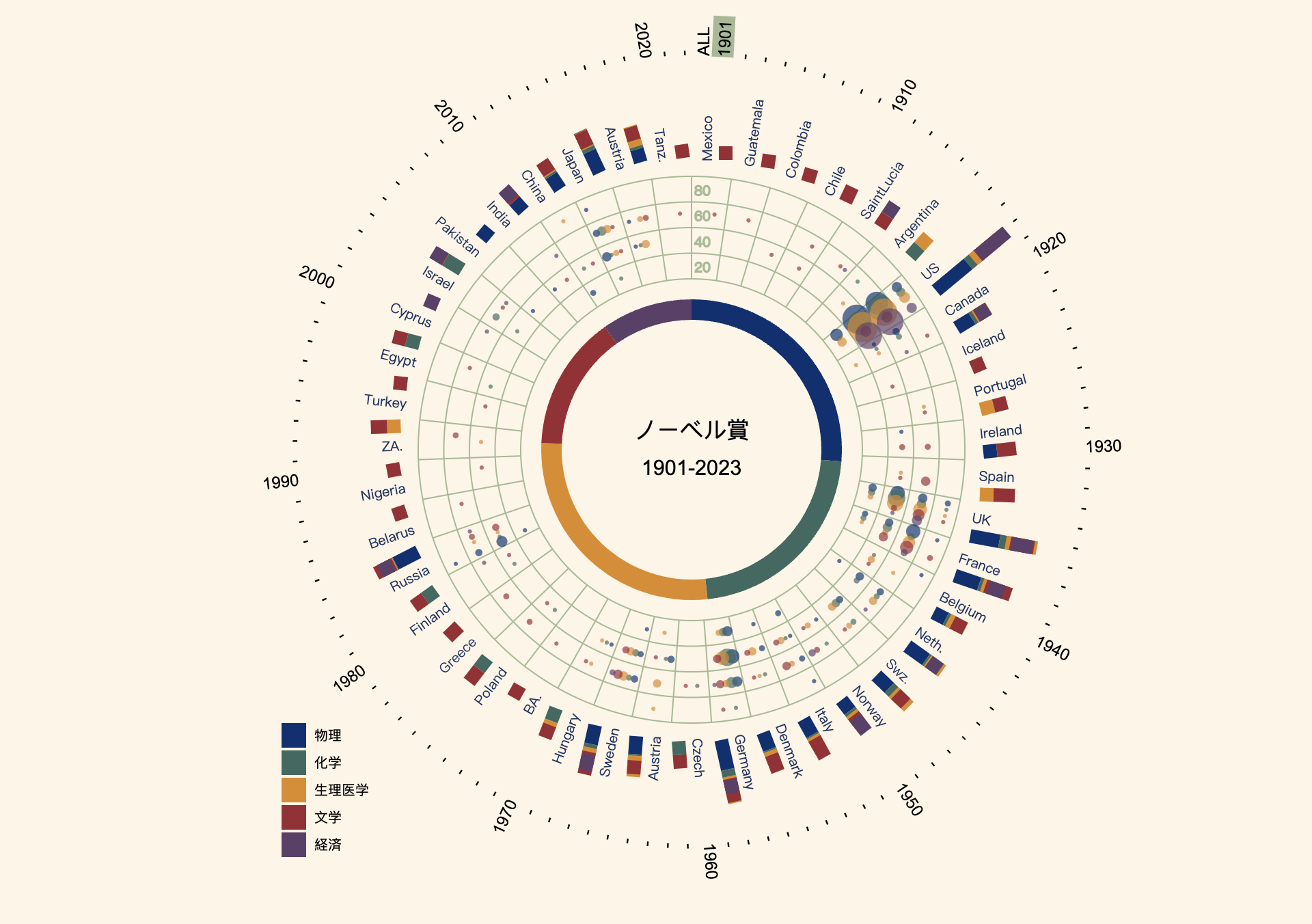AIが急速に発展している時代に、データアナリストの仕事は挑戦に直面しています。AIは効率的にコードを出力することができます。ビジネスニーズを深く理解し、「ビジネス向け開発者」になるだけでなく、データアナリストは可視化の方向にも、美的感覚を高める努力をすることができます。AIはまだ複雑で美しい可視化画像を出力する能力はありません。
以下の図は、1901年から2023年までのノーベル賞の100年間の受賞状況を可視化したものです。主に、受賞者の当時の国籍、専門分野、受賞者の年齢の可視化です。選択した可視化図形はアスタープロットです。また、画像の背景と専門分野の色は、日本の伝統色を採用しています。例えば、ENJI 燕脂、SEIHEKI青碧など。
この1枚の図から、各国の受賞数の比較、学科の傾向、40-80歳の間の受賞者数が最も多いなどの情報が簡単に見えます。これは、フロントエンドのデータ可視化がPOWERBIの可視化に比べて優れている点であり、より高度な創造性を持ち、AIに取って代わることは難しいです。
データソース:https://www.nobelprize.org/prizes/lists/all-nobel-prizes/
- 以下は 可視化.js 主要なコードロジックです:
1. 円形の各種パラメータを設定
const width = 640;
let dimensions = {
width: width,
height: width,
radius: width / 2,
pieInnerRadius: 95,
pieOuterRadius: 110,
ageInnerRadius: 125,
ageOuterRadius: 200,
countryBarRadius: 216,
yearRadius: 216 + 62,
};
2.円心を設定
const bounds = d3
.select("#wrapper")
.append("svg")
.attr(
"viewBox",
`${-dimensions.width / 2} ${-dimensions.height / 2} ${dimensions.width} ${
dimensions.height
}`
)
.attr("width", dimensions.width)
.attr("height", dimensions.height)
.append("g");
3.パイチャートを作成
function drawPieChart() {
const arc = d3
.arc()
.innerRadius(dimensions.pieInnerRadius)
.outerRadius(dimensions.pieOuterRadius);
const pie = d3.pie().sort(null);
const allPath = bounds
.selectAll("path")
// [201, 169, 210, 111, 75, 0, 0]
.data(pie(secondPieData[115]))
.enter()
.append("path")
.attr("d", arc)
.attr("fill", (d, i) => {
if (i == 5) return "#5c5c5c";
if (i == 6) return "#FFFFFF";
return nobelDotColor[i];
});
}
drawPieChart();
4.軸線を作成
const axis = bounds.append("g").attr("class", "grid-line");
function drawAxis() {
d3.range(5).map((i) => {
const cr =
dimensions.ageInnerRadius +
(i * (dimensions.ageOuterRadius - dimensions.ageInnerRadius)) / 4;
axis.append("circle").attr("r", cr);
axis
.append("text")
.attr("y", -cr)
.attr("dx", ".2em")
.attr("dy", "-.5em")
.text(i != 4 ? (i + 1) * 20 : "");
});
countryList.map((country, i) => {
const [x1, y1] = getCoordinatesForAngle(
countryScale(i),
dimensions.ageInnerRadius
);
const [x2, y2] = getCoordinatesForAngle(
countryScale(i),
dimensions.ageOuterRadius
);
axis
.append("line")
.attr("class", "grid-line")
.attr("x1", x1)
.attr("y1", y1)
.attr("x2", x2)
.attr("y2", y2);
});
}
drawAxis();
5.国名
const countryScale = d3
.scaleLinear()
.domain([0, countryList.length])
.range([0, Math.PI * 2]);
const getCoordinatesForAngle = (angle, radius) => [
Math.cos(angle - Math.PI / 2) * radius,
Math.sin(angle - Math.PI / 2) * radius,
];
function drawCountry() {
countryList.map((country, i) => {
const [x, y] = getCoordinatesForAngle(
countryScale(i),
dimensions.countryBarRadius
);
const countryGroup = bounds.append("g").attr(
"transform",
`rotate(${(countryScale(i) * 180) / Math.PI - 90}) translate(${
dimensions.countryBarRadius - 5
}, 0)`
);
countryGroup
.append("text")
.text(country)
.attr("fill", "#a29bfe")
.style("text-anchor", (d) =>
countryScale(i) < Math.PI ? "start" : "end"
)
.attr("transform", (d) =>
countryScale(i) < Math.PI
? "translate(0, 15)"
: "rotate(-180) translate(0,-7)"
);
});
}
drawCountry();
6.国と科目の積み上げ棒グラフを描く
let countryPrize = personCountPerYP[123];
let new_countryPrize = [];
const keys = ["物理", "化学", "生理医学", "文学", "経済"];
countryPrize.forEach((arr, i) => {
const new_item = {};
arr.forEach((item, j) => {
new_item[keys[j]] = item;
});
new_item["sum"] = d3.sum(arr);
new_countryPrize.push(new_item);
});
const stackedData = d3.stack().keys(keys)(new_countryPrize);
function drawCountryPrizeBarChart() {
const stackBar = bounds
.append("g")
.selectAll("g")
.data(stackedData)
.join("g")
.attr("fill", (d, idx) => nobelDotColor[idx]);
stackBar
.selectAll("rect")
.data((d) => d)
.join("rect")
.attr(
"transform",
(d, i) =>
`rotate(${(countryScale(i) * 180) / Math.PI - 90}) translate(${
dimensions.countryBarRadius - 4
}, 20)`
)
.attr("x", (d) => Math.sqrt(Math.sqrt(d[0])) * 10)
.attr("height", 10)
.attr("width", (d) => Math.sqrt(Math.sqrt(d[1] - d[0])) * 10);
}
drawCountryPrizeBarChart();
7.国-年齢-科目の散布図
function drawEachPrizeCircle() {
d3.range(countryList.length).map((iAll) => {
d3.range(5).map((jAll) => {
d3.range(5).map((kAll) => {
const angle =
countryScale(iAll) +
((kAll + 1) * ((2 * Math.PI) / countryList.length)) / 6;
const age = 10 + jAll * 20;
const personAgeToPoint = 90 - ((age - 20) / 80) * 75;
const radius = dimensions.countryBarRadius - personAgeToPoint;
const [x, y] = getCoordinatesForAngle(angle, radius);
bounds
.selectAll(`.AllPerson${iAll}`)
.data(nbAllPerson[iAll][jAll])
.join("circle")
.attr("class", `allPersonPoints_${iAll}_${jAll}_${kAll}`)
.attr("fill-opacity", 0.2)
.attr("fill", nobelDotColor[kAll])
.attr("cx", x)
.attr("cy", y)
.attr("r", 1.5 * Math.sqrt(nbAllPerson[iAll][jAll][kAll]));
});
});
});
}
drawEachPrizeCircle();
8.外側の年度目盛り
function drawYear() {
const yearRange = 123;
const yearScale = d3
.scaleLinear()
.domain([0, yearRange])
.range([0, 2 * Math.PI]);
d3.range(yearRange).map((year) => {
const [x, y] = getCoordinatesForAngle(
yearScale(year),
dimensions.yearRadius
);
const yearGroup = bounds
.append("g")
.attr(
"transform",
`rotate(${(yearScale(year) * 180) / Math.PI - 90}) translate(${
dimensions.yearRadius + 10
}, 0)`
);
const rect = yearGroup
.append("rect")
.attr("class", "perYearButton_" + year)
.attr("id", "" + year)
.attr("width", 30)
.attr("height", 16)
.attr("fill", "#A5BA93")
.attr("fill-opacity", year == 0 ? 1 : 0)
.attr("cursor", "pointer");
yearGroup
.append("text")
.text(year == 0 ? "ALL" : year % 10 == 0 ? 1900 + year : "-")
.attr("dy", "1.1em")
.attr("class", "timeText_" + year)
.attr("fill", "#000000")
.attr("font-size", 12)
.attr("font-family", "Arial")
.attr("fill-opacity", 1)
.attr("cursor", "pointer")
.attr("pointer-events", "none")
.attr("text-anchor", (d) =>
yearScale(year) < Math.PI ? "start" : "end"
)
.attr("transform", (d) =>
yearScale(year) < Math.PI
? "rotate(0)"
: "rotate(-180) translate(0, -20)"
);
rect
.on("mouseover", function () {
d3.select(this).transition().duration(100).attr("fill-opacity", 1);
d3.select(".timeText_" + d3.select(this).attr("id"))
.transition()
.duration(100)
.text(year == 0 ? "ALL" : 1900 + year)
.attr("fill-opacity", 1);
})
.on("mouseout", function () {
d3.select(this).transition().duration(500).attr("fill-opacity", 0);
d3.select(".timeText_" + d3.select(this).attr("id"))
.transition()
.duration(100)
// .attr("fill-opacity", 0);
.text(year == 0 ? "ALL" : year % 10 == 0 ? 1900 + year : "-");
});
});
}
drawYear();
